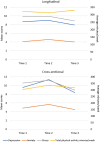Depression, anxiety, stress, and physical activity of Australian adults during COVID-19: A combined longitudinal and repeated cross-sectional study
- PMID: 36275328
- PMCID: PMC9581268
- DOI: 10.3389/fpsyg.2022.962962
Depression, anxiety, stress, and physical activity of Australian adults during COVID-19: A combined longitudinal and repeated cross-sectional study
Abstract
Background: The COVID-19 pandemic has led to a worsening of mental health and health behaviors. While physical activity is positively associated mental health, there is limited understanding of how mental health and physical activity evolve throughout the COVID-19 pandemic. This study aimed to examine changes in depression, anxiety and stress and physical activity, and associations between depression, anxiety, and stress with physical activity in Australian adults across three-time points during the COVID-19 pandemic.
Materials and methods: This study collected both longitudinal and cross-sectional data at three-time points during the COVID-19 pandemic in Australia (i.e., April, July/August, and December 2020). Australians aged 18 years and over were invited to complete online surveys hosted on Qualtrics survey platform. Linear mixed models with random subject effect and general linear models were used to analyze the longitudinal and repeated cross-sectional data respectively.
Results: The number of participants in cross-sectional surveys and longitudinal surveys was 1,877 and 849, respectively. There was an overall reduction between time 2 vs. time 3 in depression (d = 1.03, 95% CI = 0.20, 1.85), anxiety (d = 0.57, 95% CI = 0.02, 1.12), and stress (d = 1.13, 95% CI = 0.21, 2.04) scores but no significant differences in physical activity across three-time points. On average, participants who met the physical activity guidelines had lower depression (d = -2.08, 95% CI = -2.90, -1.26), anxiety (d = -0.88, 95% CI = -1.41, -0.34), and stress (d = -1.35, 95% CI = -2.13, -0.56) scores compared to those not meeting the guidelines.
Conclusion: In the context of the ongoing COVID-19 pandemic, both governments and service providers should continue to provide the public with timely mental health support and promote the benefits of physical activity, as a cost-effective strategy to improve mental health and wellbeing.
Keywords: COVID-19 pandemic; DASS-21; anxiety; depressive symptoms; distress; exercise; mental health.
Copyright © 2022 Zhao, Vandelanotte, Khalesi, Alley, Williams, Thwaite, Fenning, Stanton and To.
Conflict of interest statement
The authors declare that the research was conducted in the absence of any commercial or financial relationships that could be construed as a potential conflict of interest.
Figures
Similar articles
-
The association of resilience with depression, anxiety, stress and physical activity during the COVID-19 pandemic.BMC Public Health. 2022 Mar 12;22(1):491. doi: 10.1186/s12889-022-12911-9. BMC Public Health. 2022. PMID: 35279118 Free PMC article.
-
Maternal depressive and anxiety symptoms before and during the COVID-19 pandemic in Canada: a longitudinal analysis.Lancet Psychiatry. 2021 May;8(5):405-415. doi: 10.1016/S2215-0366(21)00074-2. Epub 2021 Mar 24. Lancet Psychiatry. 2021. PMID: 33773109 Free PMC article.
-
Coping with COVID-19: a prospective cohort study on young Australians' anxiety and depression symptoms from 2020-2021.Arch Public Health. 2024 Sep 26;82(1):166. doi: 10.1186/s13690-024-01397-z. Arch Public Health. 2024. PMID: 39327590 Free PMC article.
-
Psychological Impacts of COVID-19 During the First Nationwide Lockdown in Vietnam: Web-Based, Cross-Sectional Survey Study.JMIR Form Res. 2020 Dec 15;4(12):e24776. doi: 10.2196/24776. JMIR Form Res. 2020. PMID: 33284778 Free PMC article.
-
Is Physical Activity Associated with Less Depression and Anxiety During the COVID-19 Pandemic? A Rapid Systematic Review.Sports Med. 2021 Aug;51(8):1771-1783. doi: 10.1007/s40279-021-01468-z. Epub 2021 Apr 22. Sports Med. 2021. PMID: 33886101 Free PMC article.
Cited by
-
Effect of decrease of physical activity on depression and anxiety after the COVID-19 lockdown: A survey study.Front Psychol. 2022 Nov 17;13:961798. doi: 10.3389/fpsyg.2022.961798. eCollection 2022. Front Psychol. 2022. PMID: 36467209 Free PMC article.
-
An examination of the reciprocal associations between physical activity and anxiety, depressive symptoms, and sleep quality during the first 9 weeks of the COVID-19 pandemic in Belgium.Ment Health Phys Act. 2023 Mar;24:100500. doi: 10.1016/j.mhpa.2022.100500. Epub 2022 Dec 8. Ment Health Phys Act. 2023. PMID: 36510601 Free PMC article.
-
The relationship between physical activity and psychological sub-health among high altitude region Tibetan college students.Front Psychol. 2024 Nov 27;15:1465845. doi: 10.3389/fpsyg.2024.1465845. eCollection 2024. Front Psychol. 2024. PMID: 39664639 Free PMC article.
-
Predictors of mental health among U.S. adults during COVID-19 early pandemic, mid- pandemic, and post-vaccine eras.BMC Public Health. 2024 Feb 29;24(1):643. doi: 10.1186/s12889-024-17781-x. BMC Public Health. 2024. PMID: 38424510 Free PMC article.
-
The longer-term impact of the COVID-19 pandemic on wellbeing and subjective cognitive functioning of older adults in Belgium.Sci Rep. 2023 Jun 15;13(1):9708. doi: 10.1038/s41598-023-36718-9. Sci Rep. 2023. PMID: 37322085 Free PMC article.
References
-
- Australian Bureau of Statistics (2018). Physical activity. Available online at: https://www.abs.gov.au/statistics/health/health-conditions-and-risks/phy... (accessed December 29, 2021).
-
- Australian Institute of Health and Welfare (2003). The active Australia survey: A guide and manual for implementation, analysis and reporting. Canberra: AIHW.
-
- Australian Institute of Health and Welfare (2021a). The first year of COVID-19 in Australia: Direct and indirect health effects. Available online at: https://www.aihw.gov.au/reports/burden-of-disease/the-first-year-of-covi... (accessed December 29, 2021).
LinkOut - more resources
Full Text Sources
Miscellaneous


